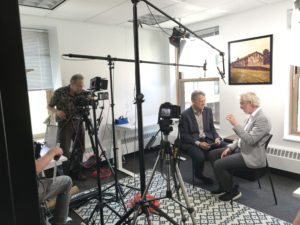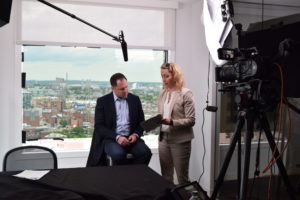Mastering Interview Videos: Conduct Successful Interviews for Corporate Marketing
Within the complicated network that is the video production industry, there are many different types of videos that can be made.
These videos span anywhere from an advertisement on television to a music video for a well-known rock band.
In the world of corporate marketing, one of the most common and significant types of video is the interview-style video.
Interview videos are everywhere; you’ve seen them on late-night talk shows, the news, documentaries, sitcoms, and advertisements.
Interviews generally feature one person who is answering questions on camera about a particular subject.
Usually unscripted, interviews offer personal opinions, information on a certain topic from an involved party or expert.
This style of video is up close and personal, which can act as a key ingredient for effective video marketing. The authenticity of interviews helps you connect with your target audience and effectively sell your main message.
Table of Contents
Types of Interviews
Although all video interviews serve similar functions, there are various types, which include:
“Talking head” interviews
“Talking heads” are the most common type of video interview, where the subject’s head and shoulders are on screen. This type of interview gives complete focus to the speaker and is often used in documentaries, journalism, and brand and other person-focused marketing videos. Marketing videos most commonly use talking head interviews to communicate the truth about their brand.
Conversational interviews
Conversational interviews usually feature both the host and the subject on screen. You have seen these types of authentic interviews on late-night talk shows!
Remote interviews
Remote interviews are becoming more common due to the lasting effects of COVID-19 and our increasingly digital world. Thanks to the internet, you do not necessarily have to be in the same room as someone to conduct a video interview! Many video chat softwares allow you to record your conversation.
Conducting the Interview
As the interviewer, you are in control of the interview and directing the person who appears on camera. The framework below will help you understand how to conduct a successful video interview in order to express your expertise and engage your target audience.
Scripting and Planning
First and foremost, it is imperative to brief your talent by explaining what the interview will entail and sending them sample interview questions. However, a common mistake interviewees make is coming over-prepared or trying to script themselves. In corporate video, your talent might struggle to remember self-assigned lines, and therefore, come across as stiff.
Set-Up
Interview set up is extremely important to ensure your video goes well. At Skillman Video Group, we typically spend about 90 minutes setting up our cameras, lights, and audio before we are ready to begin the interview with our talent.
When you are ready to begin setting up audio for your talent, have them test their microphone before filming to ensure their voice is coming through clearly.
They can do this by saying anything they want in a normal speaking voice.
If you are using a lavalier microphone on your talent for the interview, make sure the wire is not visible on camera.
If you are using a boom microphone, make sure that it is close enough to the talent that it is picking up clear sound, but far enough away that it can not be seen on camera.
Another key aspect of setting up audio is to record about a minute or two of “room tone.” Room tone is the “silence,” or low-volume sound, present in every room. It is recorded to smooth out sound in videos and make for a more cohesive final product.
Before recording, it is also important to establish eye-line, or where you want your talent to look. It is most common (and most comfortable for viewers) to have your talent look slightly off to the side of the camera, and not directly into the lens.
Interviewee Comfort
Sitting down in front of a camera, lights, and someone you hardly know can be a nerve-wracking experience. To calm their nerves, it is important to warm them up at the beginning of the interview and get them talking.
If your talent feels relaxed, they will give you more natural and truthful answers. Small talk can go a long way! Some questions you may ask to warm them up include:
- Can you please state your name?
- How are you today?
- What did you eat for breakfast?
- Can you tell me a little bit about what you do?
- Do you mind introducing yourself?
While not necessarily providing usable footage for your final video, these seemingly silly questions are a necessity for getting started on a successful interview. They also help verify audio levels and aid editors in identifying speakers and their information in post-production.
Preparing Questions for Discussion
Preparing questions in advance and ordering them in a cohesive flow will greatly benefit your production. Beginning with simple questions and moving into more in-depth questions can help with the flow of the conversation as well.
Keep questions open-ended so there is room for discussion. Follow-up questions, realized naturally as you conduct your interview, are extremely important as well to persuade your interviewee to go into more detail.
Another way to make sure your interview video flows well is to ask your interviewee to start their responses with the posed question.
For example, if your question is “How do you think the film industry has changed?”, the interviewee would start their answer saying, “I think the film industry has changed because of….”.
This technique is also helpful in giving the interview context, making it easier to edit during the post-production stage.
No matter what you are asking your interviewee, it is important to keep a conversational tone.
The most evident benefit of having a discussion rather than a straight question-and-answer session is that you’ll get more truthful answers. Additionally, not only will your talent feel more comfortable, but the whole interview will feel more genuine as well.
Although you are keeping it conversational, resist the urge to interrupt with affirmations like “yeah” and “mhm” – these can be detrimental to the sound and overall quality of your video. Instead, show that you are engaged through non-verbal cues, such as facial expressions and nodding your head.
B-Roll
When the interview is completed, or even before the interview starts in some cases, keep the cameras rolling to add visual interest to your video by capturing b-roll. “B-roll”, not to be confused with stock footage, is supplemental footage (any footage that is not your interview) that emphasizes certain points in your video.
It is used to illustrate the subject matter and add visual interest, which is why it is a key component in interview videos. Be sure to shoot any relevant b-roll, whether that be shots of your talent hard at work or the space in which you conducted your interview.
In many instances, B-roll can be just as important, or more important, than the interview footage itself. The dialogue is the “tell,” but the B-roll is the “show.” This footage can be highly varied depending on the genre and content of the video.
For example, a video about an aspiring professional tennis player will feature supplemental footage of the person playing tennis. On the other hand, a client testimonial about a painting company may feature shots of painters hard at work on someone’s house.
Some videos may include more b-roll than interview footage if the message is dependent on visuals, such as explaining the path of a solar eclipse.
Where to Use Interview Videos
A benefit to interview videos is that they are extremely versatile in explaining concepts, boosting brand awareness, and attracting your target audience.
Company website
One of the most successful places to display your interview videos is your website, especially in places where it would help explain other information. For example, if your interview video gives a general introduction to your company, displaying it on the homepage is the best option.
Social media
Social media sites are interactive and engaging, which makes them a great place to expose your audience to an informational video interview. However, each social media has different values and uses. Choosing the platform that best reflects your company will bring about success.
Sending video interviews through email connects you to clients and prospects directly. This allows you to inform and build relationships with them immediately.
Sample Interview Questions
Your interview questions should be specific enough that they evoke answers that will correctly convey the key messages of your video.
The key messages are directly spoken in an interview, whereas key themes are usually shown through visuals.
Even so, interview questions have to be customized to the client. You would not ask the same questions to the owner of a board game cafe as you would to a tennis player.
Below are the key messages and sample questions for each of the above examples to give you a better idea of the types of questions you can ask in your interviews.
Remember, your talent’s answers need to communicate the key messages of your video.
Board game cafe owner
Key messages: The board game cafe is a new and unique experience, and the games are easy to play. Customers will be taken care of and given the VIP treatment as soon as they walk in the door.
- What does your company do, and how is it different?
This basic question gives an overall picture of the company and explains why it is unique. It sets the interview up with an explanation.
- What makes your company unique in Boston?
Directly addresses what makes the company unique and different from anything else in Boston, developing “ethos” (credibility).
- What should customers expect?
The interviewee can give a run-through of the experience and convince customers to come.
- How easy is it to learn and play the games?
Addresses that the games are easy to play.
- How do you lead customers through the board game experience?
Gives the interviewee the chance to talk about how they treat customers.
Tennis player
Key messages: Breaking down stereotypes in tennis; age does not matter, training does. Live your best life and go for your dreams. Enjoy the process because it only gets better.
- When did you find your love for tennis?
This basic question introduces you to the talent and shows their passion for the subject.
- What gave you the idea for this project?
Further introduces you to the talent and topic, establishing credibility.
- Why did you decide to take this on now?
This follow up question can persuade the interviewee to go into more detail and dig deeper.
- What are your goals for the future?
Addresses aging and inspires others, appealing to “pathos,” or emotions.
- What do you want people to know about aging and playing sports?
This question directly addresses the key message of how aging and playing sports intersect.
Frequently Asked Questions
What are the key steps to prepare for an interview video?
Preparing for an interview video involves several crucial steps to ensure a successful outcome.
Start by briefing your interviewee about the purpose of the interview and providing sample questions to help them prepare. Plan the interview setup, including selecting the right location, setting up cameras, lighting, and audio equipment.
Test the microphone and record room tone to ensure high-quality sound. Establish eye-line direction for the interviewee and create a comfortable environment to help them relax and provide natural responses.
These steps help in creating a professional and engaging interview video.
How can I ensure my interviewee is comfortable and provides natural answers?
Making your interviewee comfortable is key to obtaining natural and genuine responses. Begin with small talk and lighthearted questions to break the ice and ease any nerves.
Questions like “Can you tell me a little about yourself?” or “How are you today?” can help.
Maintain a conversational tone throughout the interview, avoiding interruptions and affirmations like “yeah” or “mhm” that can disrupt the sound quality. Use non-verbal cues, such as nodding and facial expressions, to show engagement.
A relaxed interviewee is more likely to provide honest and insightful answers, enhancing the quality of your video.
What are the different types of interview videos, and when should I use each?
There are three main types of interview videos: talking head interviews, conversational interviews, and remote interviews.
Talking head interviews feature the subject’s head and shoulders on screen, focusing entirely on the speaker. These are ideal for documentaries, journalism, and brand-focused marketing videos.
Conversational interviews show both the host and the subject, creating a dynamic interaction seen on talk shows and panel discussions.
Remote interviews, conducted over video chat software, are suitable for situations where in-person meetings are impractical, allowing for flexibility and convenience.
Choose the type based on the context and goals of your interview.
Why is B-roll footage important in interview videos?
B-roll footage is essential in interview videos as it adds visual interest and context to the main interview content.
It includes supplemental footage that emphasizes key points, illustrates the subject matter, and enhances the overall storytelling. B-roll can include shots of the interviewee at work, relevant locations, or activities related to the interview topic.
This footage helps to break up the talking head shots, making the video more engaging and visually appealing. It also supports the narrative by providing visual examples of the interviewee’s points, creating a more cohesive and compelling video.
How can interview videos be effectively used in marketing?
Interview videos are versatile tools in marketing, helping to explain concepts, boost brand awareness, and attract target audiences.
They can be featured on company websites, particularly on the homepage or relevant product/service pages, to provide an authentic introduction to the brand. Sharing interview videos on social media platforms can engage followers and encourage interaction.
Email marketing campaigns can use interview videos to connect directly with clients and prospects, building relationships and providing valuable information. By showcasing real people and their experiences, interview videos enhance credibility and foster a deeper connection with the audience.
Share:
Search our blog:
Follow us on:




